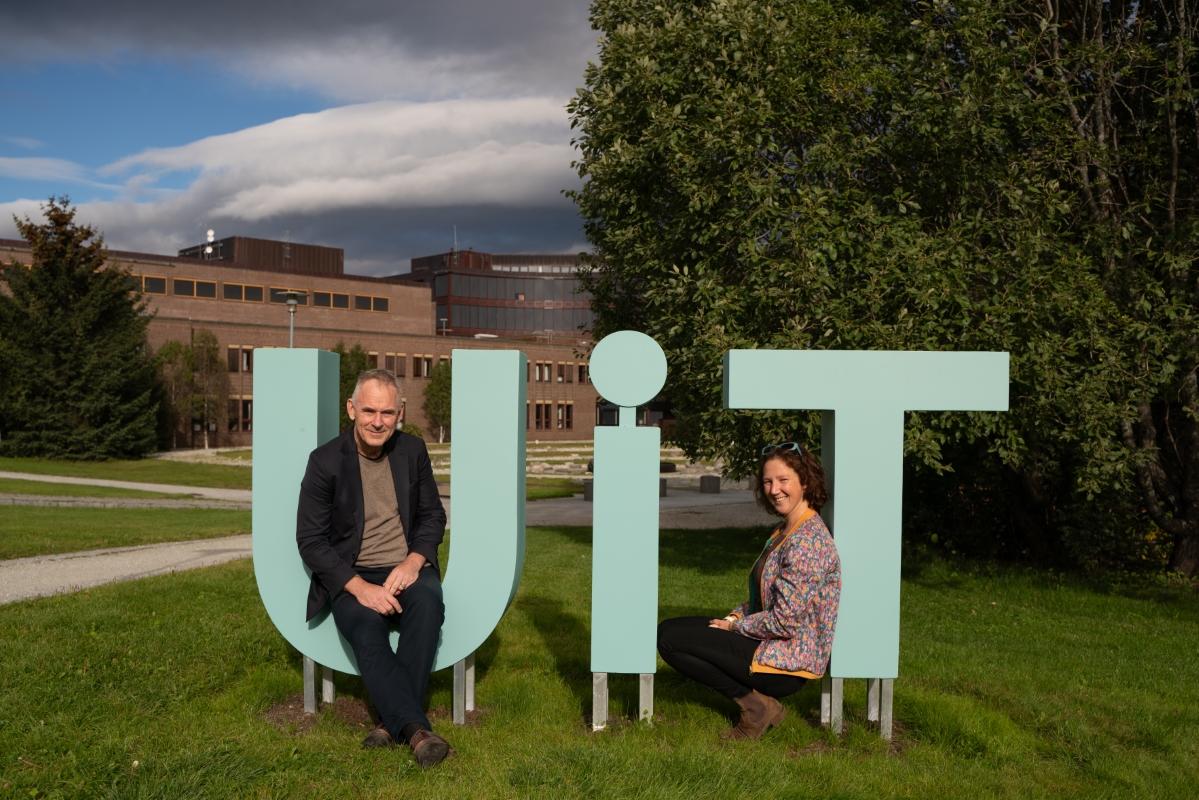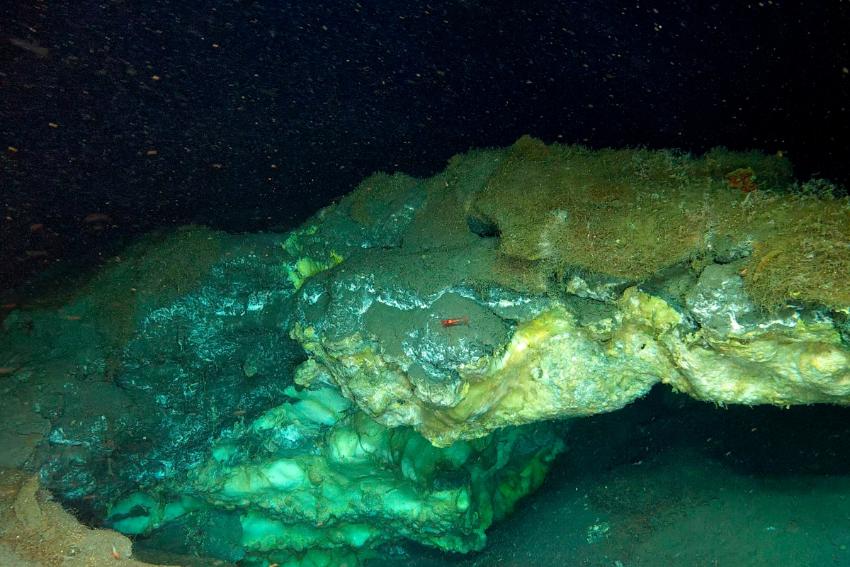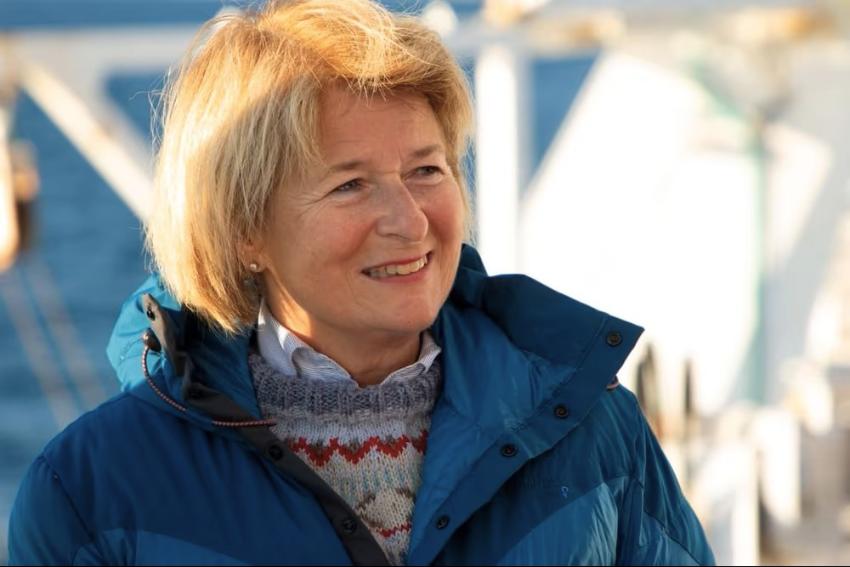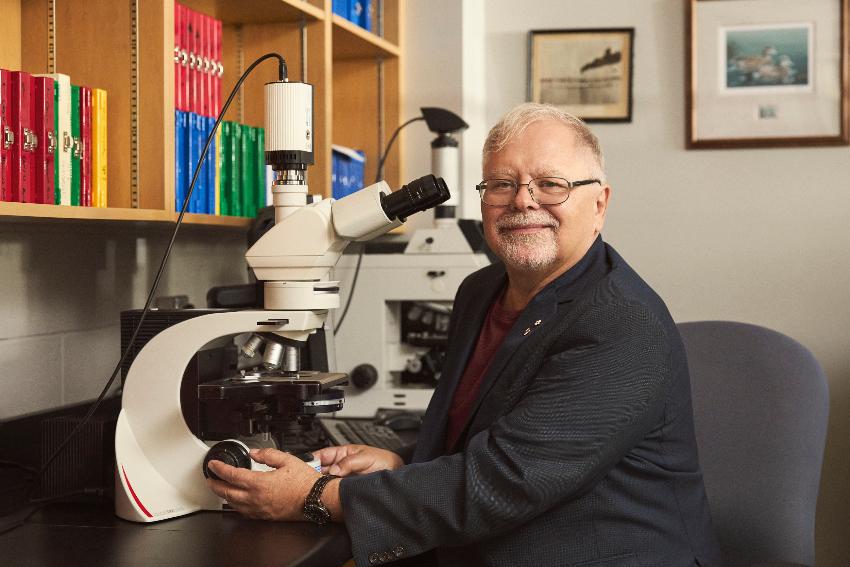ArcHum campus tour with Sverker Sörlin
Renowned history professor Sverker Sörlin visited UiT Tromsø 5th and 6th September 2024. He was particularly satisfied with UiT’s ambitions to collaborate across boundaries of all kinds.

Sverker Sörlin is professor of environmental history at KTH in Stockholm. He has a longstanding career in scholarship, policy advice, academic leadership and as a public intellectual he's part of the team of the just recently inaugurated Centre of Excellence for Anthropocene History at KTH Royal Institute of Technology in Stockholm. He is member of the university board of Umeå University that has an Arctic Centre that serves as a connectivity hub for arctic transdisciplinary research and education.
The purpose of the campus tour was to meet different research environments at UiT that are working within the Arctic humanities.
– The visit gave scholars from the humanities the possibility to present their work and give a brief insight into various ongoing research projects, says Lilli Mittner, scientific coordinator of the newly established Centre for Arctic Humanities.
Centre for Arctic Humanities (ArcHum)
ArcHum is a newly established unit at UiT The Arctic University of Norway that coordinates various research environments.
The main purpose is to strengthen professional communities in the field of Arctic humanities, develop collaborative relationships across relevant units at UiT, and advance cooperation with other universities.
The center is a response to the challenges in the Research Council's evaluation of the humanities in Norway and a Norwegian parliamentary report on the Humanities in Norway (2016-2017), as well as to UiT's humanities strategy (2021), and UiT's strategy Eallju – Developing the High North: UiT’s strategy towards 2030 (2022).
ArcHum was initiated by the Faculty of Humanities, Social Sciences and Education, The Arctic University Museum of Norway and Academy of Fine Arts, and the University Library.
After a meeting with the board and reference group, Sörlin was introduced to ongoing research activities in the research group Creating the New North, led by Sigrun Høgetveit Berg. The interdisciplinary group is composed by researchers working in various medieval and early modern topics such as maps, witchcraft trials, trade on the northern seas, church organization, Saami religious history and the north in Spanish literature. Currently the group is looking into the history of whales and whaling and is in an initial phase of developing a new project.
He further met the research group Worlding Northern Art, represented by Elin Kristine Haugdal and Hanne Hammer Stien. The group is doing research at the intersection of art history and visual culture in Northern Norway and the Circumpolar North and incorporates curatorial practices and artistic research.
Ingeborg Høvik leads a group of international scholars and artists who contribute to the ongoing efforts of decolonizing dominant Arctic History. With funding from the Research Council of Norway (RCN) the Arctic Voices project gathers stories that point to those who were on the receiving end of imperialism in the extended nineteenth century. The project just had an exhibition rooted in five years of archival work, workshops and collaboration at Riddu Riđđu Festivála.
Another RCN funded interdisciplinary project, Arctic Auditories, led by Katrin Losleben, engages scholarship and methods from sound arts, human geography and applied ethnomusicology to develop strategies for understanding environmental change through sound. The project is based in feminist methodology and focuses on water environments.
The Saami language technology research group Giellatekno, led by Trond Trosterud, develops grammar-based language models for Saami and other circumpolar languages and puts them to use in a variety of practical applications. It does research both on the grammars themselves, on the models and on the effect of the use of these practical programs.
Sverker Sörlin further met the leaders of the High North Population Studies (Hilde Sommerseth), Place, power and mobility (Anniken Førde) and the UiT Environmental Humanities Network (Kate Maxwell).
– I was impressed with the variety of topics covered by scholars at UiT working within Arctic Humanities, Sörlin said after his visit.
– It is really a privilege to be able to envision so many research groups in just a couple of days, and it all looks very promising. The size and capacity of UiT’s faculty staff seems just ideal to work on a comprehensive collaborative scheme like this, he said.
Sörlin also visited the Centre for Sami studies, the Centre for Peace Studies and the Polar Museum. Marit Anne Hauan gave a tour through the exhibition ‘Queering Polar History’ which is norm-critical and crosses borders in various ways. The University Library recorded a conversation at the RESULT podcast studio with Per Pippin Aspaas.
Sörlin has been a frequent visitor to the UiT campus since the 1980s. His most recent presentation was on his ideas on integrative humanities for the Norwegian conference of humanities deans in 2021.
– The research environments showed a broad range of UiT research, consistently of good quality. I was particularly happy to note the serious ambitions to collaborate across boundaries: disciplines, languages, nations, traditions. Adding the artistic fields is also important. They were more numerous at Tromsø than I knew since before – and also more research oriented, he said.
Anne Britt Flemmen, the Dean at the Faculty of Humanities, Social Sciences and Education underlines the importance of learning from international and experienced scholars when it comes to building strong research environments.
– I think it is important that our researchers have the possibility to discuss their research and their future plans with such an accomplished and experienced scholar as Sverker Sörlin. I understand that they really appreciated the possibility to enter into dialogue with him, get inspiration, new impulses and advice, she said.
Melina Duarte, newly appointed head of the Department of Philosophy and first semester studies sees the potential to send a delegation from ArcHum and from her department to Sörlin’s home institution, KTH in Stockholm. It will be particularly interesting to visit the Environmental Humanities Laboratory that is located together with the Division of Philosophy and the Division of History of Science, Technology and Environment.
– A visit to exchange ideas between our research units will create further synergies between UiT and KTH. I am very happy that we now have ArcHum for facilitating these important interactions, Duarte said.
Lilli Mittner hopes for inspiration for increased activity at UiT.
– One of the success criteria for Archum is to have established new strong, interdisciplinary research networks and collaborative constellations at UiT that succeed in the competition for external funding and that make their research visible to a broad audience locally, nationally, and internationally, said Mittner.
Knowledge about Arctic issues need to be actively disseminated both in academia and to the general public. UiT is putting significant focus on activities related to digital humanities and other humanities-based innovation.
Research environments at UiT are currently connected to the Centre for Arctic Humanities
- Arctic Archaeology
- Arctic Auditories
- Arctic Sustain
- Arctic Voices
- Centre for Sami Studies
- CRAFT lab. Knowledge Integration and Blue Futures
- Creating the New North
- Department for Research and Education Support, University Library
- Ethnographic Action: Researching Transformations of Humans and Environment on a Disrupted Plane t (EA:RTH)
- Environmental Humanities (EnvHum)
- Environmental Philosophy (EnvPhil)
- Faglig nettverk for forskning og kunnskapsutvikling om kvenske tema
- Feminist Theories in the Arctic (FemArc)
- Fuglan veit
- Giellatekno
- Indigenous Religion(s): Local Grounds, Global Networks (INREL)
- Interdisciplinary Phenomenology
- Narrating the Postcolonial North
- PEACE
- Place, power and mobility
- Research on Sámi Research and on Representation of Sámi Cultural Heritage (SamForsk)
- Urban Transformation in a Warming Arctic (UrbTrans)
- Worlding Northern Art (WONA)
- Exploration, Exploitation and Exposition of the Gendered Heritage of the Arctic (XARC)
Kortnytt fra Faculty of Humanities, Social Sciences and Education, Institute of philosophy and first semester studies, Centre for women's and gender research, Centre for Sami Studies
-
Fiskeri- og havbruksvitenskap - bachelor
Varighet: 3 År -
Fiskeri- og havbruksvitenskap - master
Varighet: 2 År -
Master of Philosophy in Visual and Multimodal Anthropology
Varighet: 2 År -
Arkeologi - master
Varighet: 2 År -
Instrument 2
Varighet: 1 År -
Hørelæredidaktikk - master
Varighet: 2 År -
Peace and Conflict Transformation - master
Varighet: 2 År -
Indigenous Studies - master
Varighet: 2 År -
Theoretical Linguistics - master
Varighet: 2 År -
Geosciences - master
Varighet: 2 År -
Biology - master
Varighet: 2 År -
Technology and Safety - master
Varighet: 2 År -
Law of the Sea - master
Varighet: 3 Semestre -
Biologi - bachelor
Varighet: 3 År -
Sosiologi - master
Varighet: 2 År -
Nordisk - årsstudium
Varighet: 1 År -
Strategisk ledelse og økonomi - erfaringsbasert master
Varighet: 5 Semestre -
Engelsk - årsstudium
Varighet: 1 År -
Luftfartsfag - bachelor
Varighet: 3 År -
Samfunnsplanlegging - bachelor
Varighet: 3 År -
Pedagogikk - bachelor
Varighet: 3 År -
Sosiologi - bachelor
Varighet: 3 År -
Arkeologi - bachelor
Varighet: 3 År -
Spansk - årsstudium
Varighet: 1 År -
Statsvitenskap - bachelor
Varighet: 3 År -
Pedagogikk - master
Varighet: 2 År -
Likestilling og kjønn - årsstudium
Varighet: 1 År -
Historie - bachelor
Varighet: 3 År -
Geovitenskap- bachelor
Varighet: 3 År -
Samfunnsplanlegging og kulturforståelse - master
Varighet: 2 År -
Kjemi - bachelor
Varighet: 3 År -
Økonomi og administrasjon - bachelor
Varighet: 3 År -
Samfunnssikkerhet - bachelor
Varighet: 3 År -
Økonomi og administrasjon, siviløkonom - master
Varighet: 2 År -
Ledelse, innovasjon og marked - bachelor
Varighet: 3 År -
Ergoterapi - bachelor
Varighet: 3 År -
Grunnskolelærerutdanning for 1.-7. trinn - master
Varighet: 5 År -
Grunnskolelærerutdanning for 5.-10. trinn - master
Varighet: 5 År -
Samfunnssikkerhet - master
Varighet: 2 År -
Kunst - bachelor
Varighet: 3 År -
Nordsamisk fra begynnernivå - årsstudium
Varighet: 1 År -
Kunsthistorie - master
Varighet: 2 År -
Musikkutøving - bachelor
Varighet: 4 År -
Religionsvitenskap - årsstudium
Varighet: 1 År -
Russisk - årsstudium
Varighet: 1 År -
Romfysikk, sivilingeniør - master
Varighet: 5 År -
Klima og miljøovervåkning, sivilingeniør - master
Varighet: 5 År -
Samfunnsøkonomi med datavitenskap - bachelor
Varighet: 3 År -
Sosialantropologi - bachelor
Varighet: 3 År -
Organisasjonsdesign og ledelse - master
Varighet: 2 År


